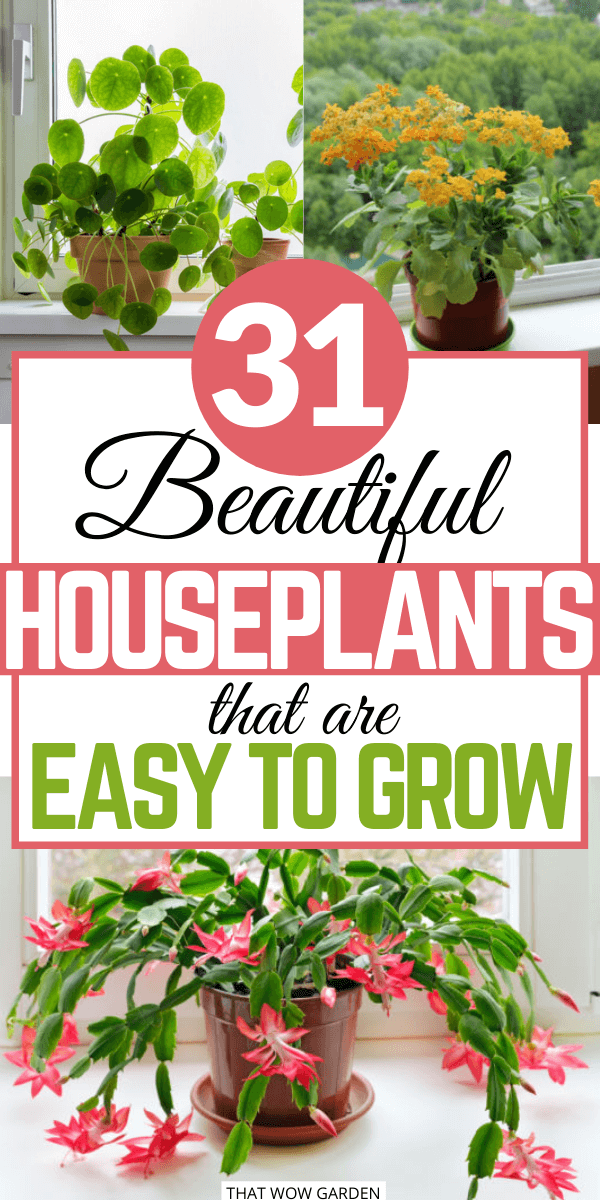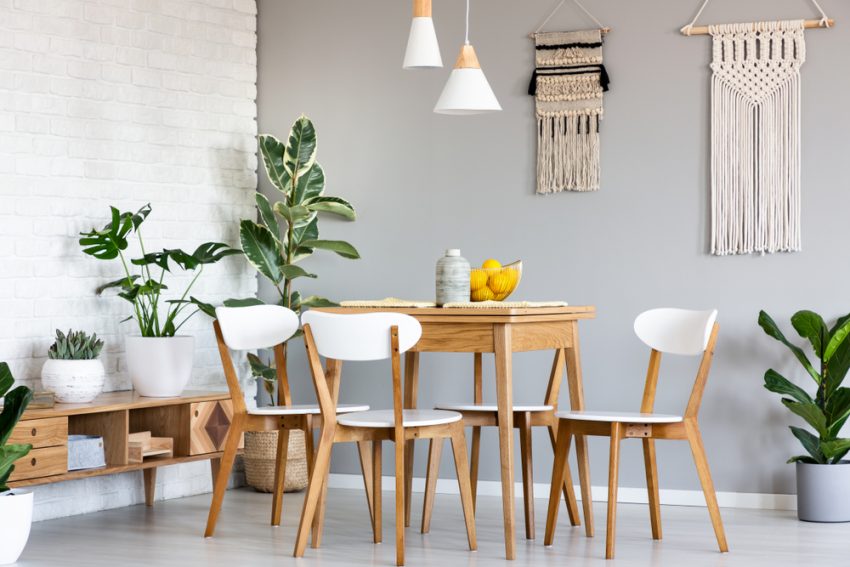Are you on a mission to spruce up your house with plants and make it look more welcoming? Or are you trying to prove to yourself that you can take care of another living being? Whatever be the reason, buying houseplants can seem daunting when you’re a beginner when it comes to gardening. But don’t worry, not every houseplant requires extensive care to thrive. There are several plants that are low-maintenance and have got looks to die for!
When you are looking for the perfect plant to start your gardening journey, the key is to analyze your indoor environment and amenities and choose houseplants accordingly. If you have a dark room, go with low-light plants like dracaena and prayer-plants. If you have a sunny balcony or window, go for sun-lovers like ponytail palm and jade. We have a lot more options for you!
So, go ahead and check out our curated list of 31 easy to grow houseplants for beginners and get your gardening inspiration and care tips, all in one place!
31 Easy to Grow Houseplants for Beginners
1. Peperomia
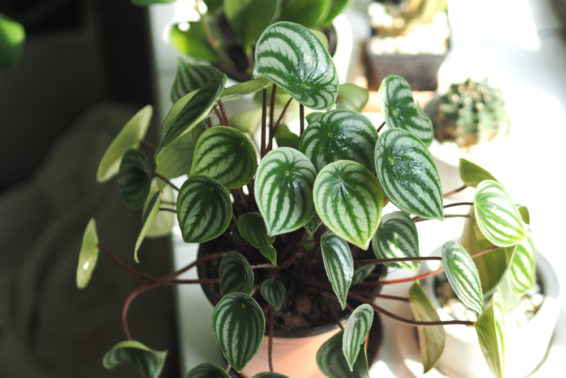
Also known as the radiator plant, Peperomia belongs to the large family of Piperaceae and is native to Central and South America. There are over 1000 species of Peperomia to choose from and you can opt for the right variety to beautify your home.
This beautiful ornamental plant will improve the look of your desk or shelves and you can also choose this as a centerpiece for dining tables. The leaves vary in size, shapes, and color, so choose the one that catches your fancy. Peperomia would be the right choice for beginners since it is forgiving and it can tolerate a decent amount of neglect.
This plant requires medium to bright light and it isn’t much affected by light fluctuations. In optimum conditions, it can grow up to 36 inches tall when planted in loamy soil with good drainage. Water it when the topsoil is dry and you will see your Peperomia growing happily! Grow it alone or group it with similar varieties to make your job easy.
2. Christmas Cactus
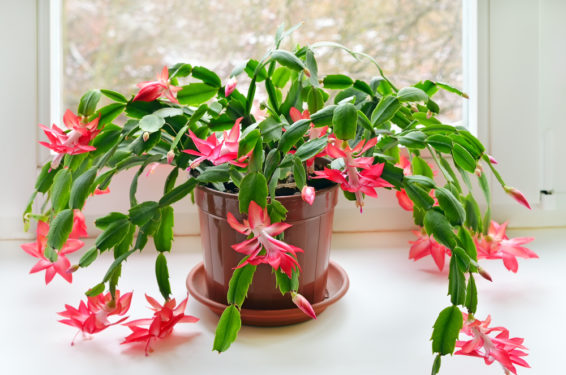
Not a big fan of regular, thorny cactus? Don’t worry, we have a unique and beautiful species from the cacti family—Schlumbergera bridgessii or Christmas Cactus. It is found in the coastal mountains of south-eastern Brazil and is slightly different in appearance than its desert-dwelling cousins.
The Christmas Cactus is not that difficult to care for and offers a graceful arching appearance. Its long, segmented stems with satiny flowers in lilac, salmon, red-orange, or white will catch anyone’s eye. They usually bloom in late December and must be pruned in June.
This plant requires bright, indirect light, and container soil. Keep it in a pot with drainage holes and water it whenever the top layer of soil feels dry. Start watering it actively when it starts blooming.
3. Wandering Jew
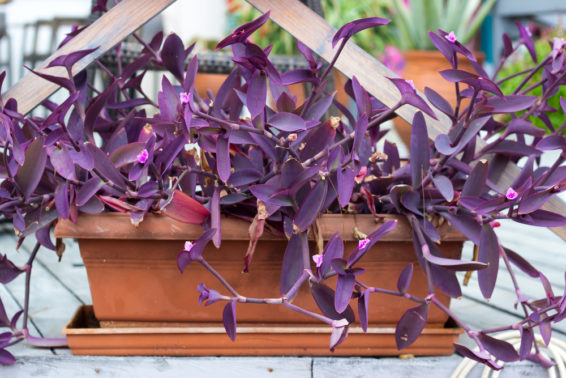
The Tradescantia zebrina or T. Fluminensis has an interesting common name—Wandering Jew. It belongs to the family of Commelinaceae and is a beginner-friendly houseplant. A native to Mexico, the purple and white hued leaves make it an amazing ornamental plant. The leaves turn green as they grow older and this flowering plant blooms with pink, white, and purple flowers in spring or early summer.
You would need good soil and enough humidity to make this plant thrive. It also requires bright, indirect light as the color of the leaves can fade in the absence of enough light. You can water it as soon as the soil gets a bit dry.
If you are a beginner, go ahead with this as they are difficult to kill and don’t die with minimal neglect.
4. Cast Iron Plant
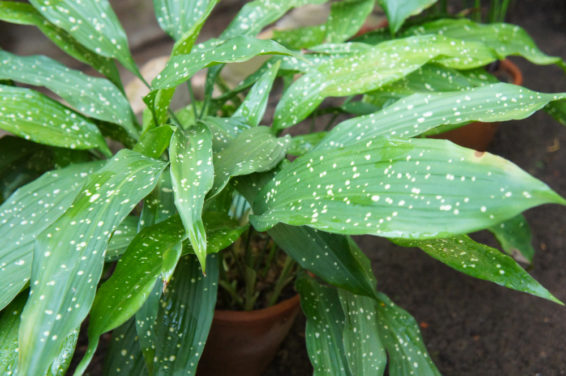
I am guessing that the name has already given you an idea about this plant—it’s one tough cookie and nearly indestructible! Belonging to the Lily family, the Cast Iron plant or Aspidistra elatior has Japanese and Chinese roots. It is believed that this houseplant can live up to 50 years and it is a great choice for beginners.
It has dark green, long and textured foliage and it looks great if grouped together with other varieties. This plant is a slow grower and it is the right choice if you want to bring some green inside your house.
It can keep thriving with low light, fluctuating temperatures, and moderate humidity. It hates overwatering and you must water it only when the topsoil is dry—give it even less water during winters.
Bring this beauty home if you want to try out your gardening skills, and I am sure you won’t regret it.
5. Madagascar Dragon Tree
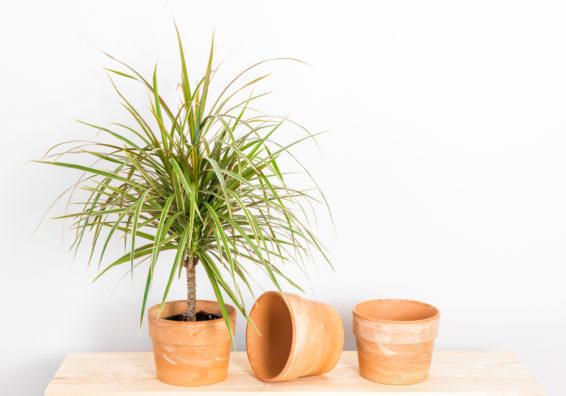
You must have come across this one at least a dozen times—it’s very easy to care for it and hence is a popular houseplant. The scientific name of Dracaena marginata is a combination of its native place ‘Madagascar’ and its cousin Dracaena Draco. Some types of Dracaena are well-known for their tendency to ooze blood-like resin which is pretty interesting.
With good care, it can grow up to 6 feet indoors. You must ensure that the soil is moist, and that’s it. It has to be kept in a bright room away from direct sunlight and can tolerate enough neglect.
The slim, arching leaves with green leaves and red outlined foliage makes it look attractive in its own way. However, these leaves grow neatly upwards and not in different directions. Make sure that you prune it now and then to keep it short or it might just grow up to 20 feet!
The leaves of this plant are toxic for cats and dogs—don’t let your pet chew on them.
6. Moth Orchid
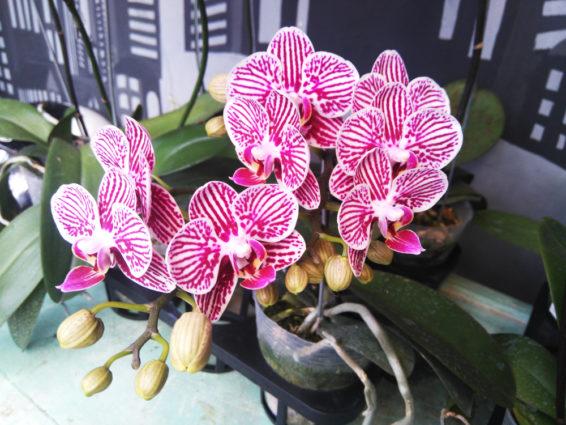
Here comes the prettiest of the lot and a real beauty, orchids. The Phalaenopsis orchid, also known as the Moth Orchid, is a well-known variety and can be a wonderful choice when you are looking for houseplants. It is low-maintenance and those blooms last up to 4 months.
The plant originates in the Philippines, Australia, and South-East Asia and it belongs to the Orchidaceae family. Those glorious colored flowers would bloom once or twice a year and last for months. It is also believed that Moth Orchids can survive for decades with good care. Grace your coffee tables and side tables with them to get a lot of compliments.
Don’t plant this in normal soil—use fir bark, clay pellets, or sphagnum moss to grow orchids. They require bright light, but they get burned easily, so don’t keep it near a window sill. Phalaenopsis orchids hate overwatering and you should only water it when the potting medium is dry. So, are you ready to bring this beauty home?
7. Widow’s Thrill
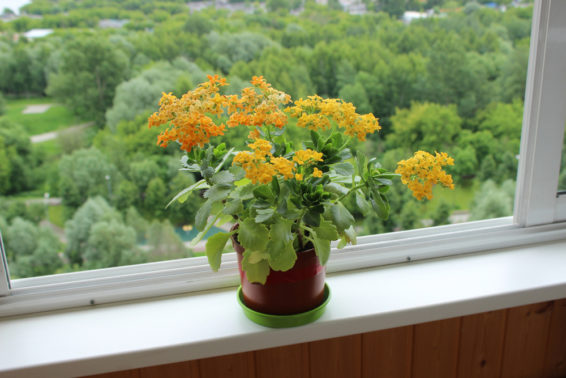
Kalanchoe, commonly known as Widow’s Thrill, is a tropical succulent that is native to Madagascar. From varying in colors of the blooms to shapes of the leaves, it also has double flowering varieties that can hold up to 26 petals per bloom. Impressive, right?
It is a water-retaining succulent that grows colorful, bell-shaped flowers and is mainly a lover of moderately dry climate. Widow’s thrill is also fine with temperature swings and you can change their position from one room to the other without any significant health effect—but if the temperature goes beyond 40 degrees it can kill the plant.
Kalanchoe needs plenty of sunlight to bloom and so it must be potted in a bright window sill. It can survive in soil of combination like peat moss and perlite and you have to water it only when the topsoil is dry. You will come across this pretty thing in most florist shops.
This plant is toxic for pets if they ingest it. So, it is recommended not to buy it if you have a pet.
8. Dumb Canes
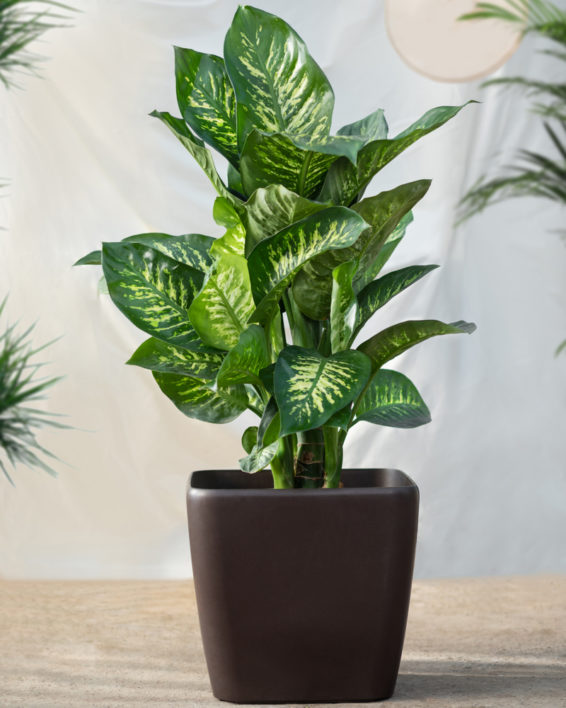
With arching pointed leaves that can grow up to 20 inches, Dieffenbachia or Dumb Canes is a genus of Araceae which is a tropical flowering family. Native to the Caribbean and South America, this is an ornamental houseplant with canelike stems.
It has large leaves that vary from variety to variety and the plant can also blend in a mixed grouping of colorful foliage. The name Dumb Cane comes from the toxic sap in the leaves that can cause numbness and swelling of tongues if chewed by humans or pets.
However, taking care of it is not much scary. It would need low to medium sunlight—indirect would be the best. An evenly moist soil must be maintained and water it when the topsoil is dry. It is quick to show signs like drooping if it needs water and beginners will appreciate this quality lot! What better than your plant telling you that it needs water?
9. Guzmania Bromeliad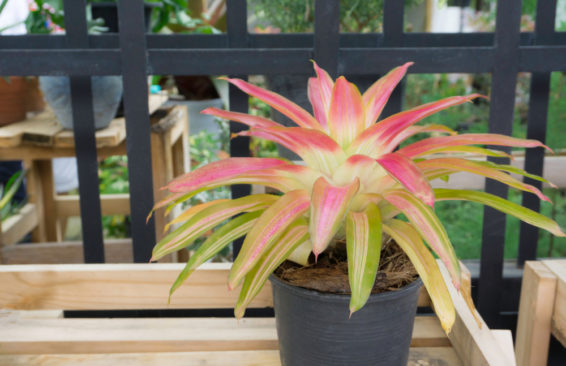
A houseplant with unique leaves, the Bromeliad belongs to the Pineapple family and it can be a rewarding choice for both novice and experienced gardeners. These are perennials native to Florida and Mexico. Those tough and long-lasting leaves can bring a touch of class and authenticity to your home.
Choose a well-draining soil meant for orchids and is rich in organic matter. Bromeliads grow well in a hot environment and they need bright, indirect light to thrive. Water them once a week and lessen the frequency when winter arrives.
Your Bromeliad can pass for an ornamental or decorative plant any day and it can be a sassy addition to your indoor decor.
10. Chinese Money Plant
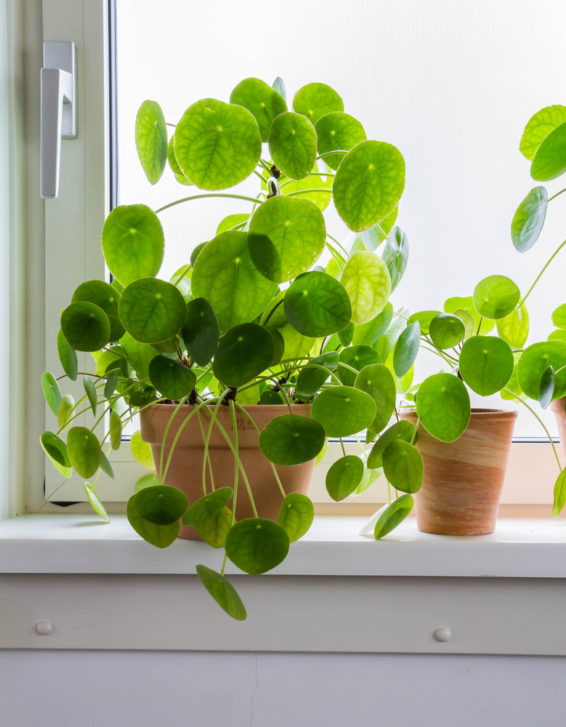
All of us have heard about money plants at some point in our lives. They are unique, sophisticated, and perfect for your living room. The Pilea peperomioides can help you if you have a shelf or desk that needs a green touch. It is rarely available but very popular in the U.S. So if you know someone with a Chinese money plant, ask them for a cutting.
It has many common but interesting names like Bender plant, mirror grass, UFO plant, and so on. It is widely found in the provinces of Southern China and will definitely spruce up your apartment.
The Chinese money plant loves the sunlight and you will notice the leaves tilting towards the light. This low-maintenance plant needs well-draining soil and routine watering only when the topsoil is dry. It will show signs like drooping when it needs water, so keep an eye out for that.
11. Lucky Bamboo
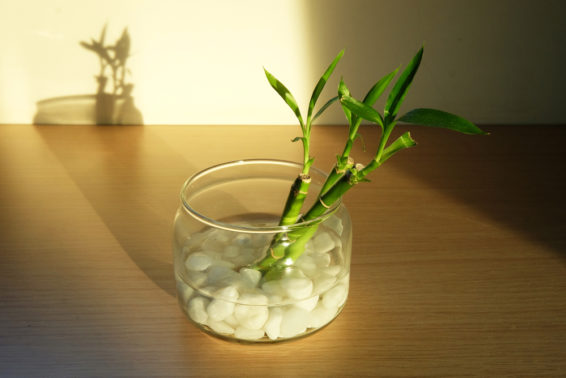
I don’t know if it’s just an old-age belief or it really does bring luck, but if you are looking for really low maintenance yet beautiful houseplant, Lucky Bamboo is the one for you. Dracaena sanderiana, a species belonging to the flowering family of Asparagaceae, is a great houseplant for beginners. It is a Central African native and people believe that it brings happiness and prosperity.
It can grow in any soil and needs about an inch of water if you are growing it in a jar of water or plant vase. Lucky bamboo is not too fussy about light conditions, but they enjoy bright, indirect sunlight and tend to grow towards the sun when there is a lack of light.
When the roots are red, that means your Lucky Bamboo is healthy and happy. Choose bottled or drinking water for watering them as they are chlorine sensitive. You can also grow lucky bamboo in soil but choose well-drained potting soil for this purpose.
Though very rare, look out for mealybugs and spider mites that can attack your bamboo, but other than that you’re good to go!
12. Hoya
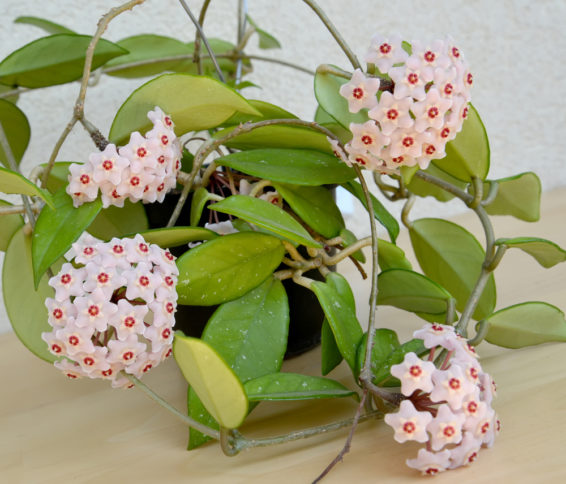
Hoya or the Wax Plant is a pretty houseplant with thick, fleshy leaves and beautiful blooms. It is fast-growing and has both smooth and shiny foliage. Those star-shaped colorful blooms have a waxy texture and a sweet scent.
A genus of the dogbane family, Hoya is native to several Asian countries like Malaysia, Thailand, Bangladesh, and so on. You might have seen a variety of Hoya before in someone’s kitchen, trailing upwards from a hanging basket.
Caring for a Hoya is really easy, just like most of the vines. The foliage requires medium light, but those pink and white blooms require bright but indirect light. They love moderately dry soil and maintain good humidity as it is a tropical plant. Water regularly to make it flourish and grace your interiors.
Also, make sure that you prune your Hoya whenever you feel like it is growing out of control!
13. Zebra Plant

A colorful Brazilian succulent, Zebra plant would be a good choice for beginners who are afraid of dipping their toes into gardening. Also known as Haworthia fasciata, this plant a native to South Africa and forms fleshy and glowy green rosette leaves.
The plant has white bands amidst the green foliage and hence it is called a Zebra plant. The leaves are quick to show signs of neglect—they will droop if they receive less water than necessary.
It needs a decent amount of moisture to survive and bright, indirect sunlight would be best. Keep the soil consistently moist but don’t overwater it. Grow it in a well-drained soil like cactus growing medium and fertilize it once a year to make it flourish.
14. Boston Fern
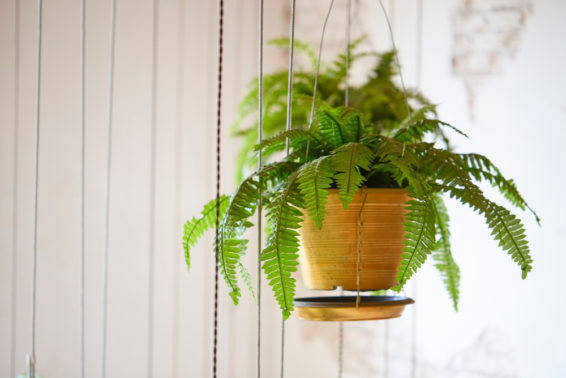
I am sure you have come across Boston Fern several times—it is a fern species that is native to tropical regions throughout the world. Also known as Nephrolepis exaltata and sword fern, it belongs to the Lomariopsidaceae family.
These lush green plants are easy to grow and have limited demands like high humidity and indirect sunlight. Place the Boston Fern in a high humid zone or you can invest in a humidifier to keep it healthy. Without them, the plant may show signs of distress.
The key to growing Boston Fern is to keep the soil moist most of the time—it must also contain high peat moss. The plant is prone to infestation by pests, so keep an eye out for those pesky little buggers.
15. Peace Lily
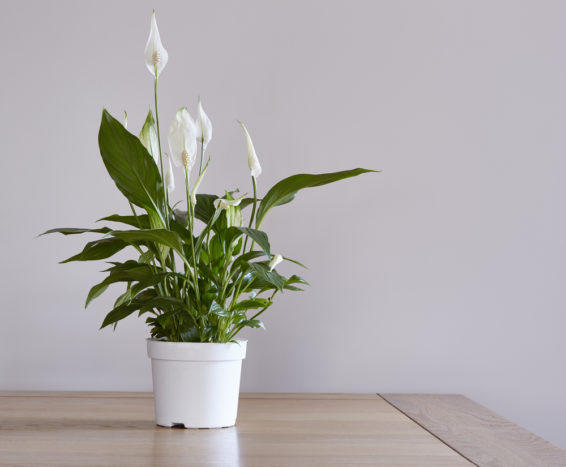
Have you always been intimidated by peace lilies? The plant care for this one is not a Herculean task like we’ve always assumed. In fact, Peace lilies are fairly easy to grow and have small demands like bright light and regular fertilizing.
Peace lily or Spathiphyllum is a member of the Araceae family and is native to the tropical regions of America and Asia. Also known as closet plants, peace lilies have air-purifying qualities as well. Those heavenly white blooms are the main attraction of this houseplant and they are my favorite too!
It requires well-drained potting soil and enjoys moisture, but not overwatering. Peace lilies are sensitive to changes in the environment and might not survive major fluctuations. Some beginners might notice the leaves turning brown, it is just a side effect of excess fluoride in tap water—switch to distilled water in such a case.
Peace lilies can be mildly toxic to pets and children if they’re ingested, so keep these plants out of reach.
16. ZZ Plant
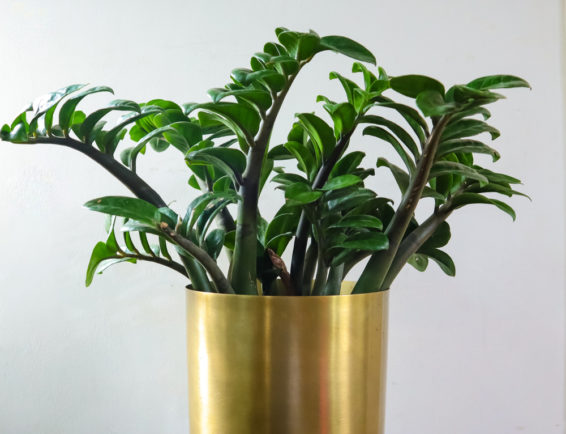
If you want to add some sass to your indoor decor, the ZZ plant is the right choice with its graceful leaves. This is an almost indestructible plant and can tolerate a lot of neglect.
The botanical name of this plant is Zamioculcas zamiifolia but it was shortened to ZZ to make the pronunciation easier. This tropical perennial is native to eastern Africa and South Africa.
This plant has stems that are wand-like in shape—they start thick and bulbous at the base, and tapers after a point. Although it’s a flowering plant, you’ll find flowers on it very rarely. But its beautiful dark green leaves make up for this.
The ZZ plant is one of the easiest houseplants to grow and it also has air purifying capabilities. You can grow it in low levels of light and keep it away from direct sunlight. Water it when the topsoil is dry—water balance must be maintained because this plant is prone to stem rot.
This is an attractive option for beginners, but it could be poisonous if touched or ingested. So, wear gloves to be on the safe side and keep it out of reach of pets and children.
17. Jade Plant
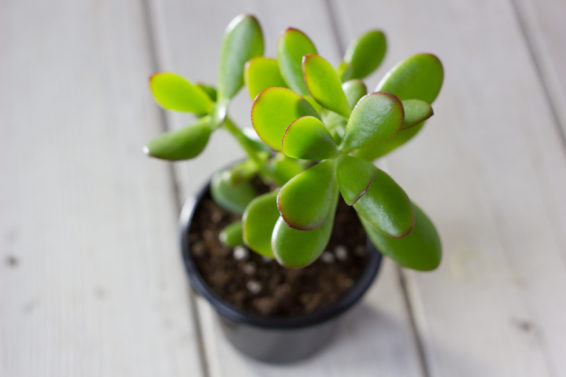
Potentially one of the best succulents for beginners, the Jade plant is native to the KwaZulu-Natal and some provinces of South Africa. Crassula ovata or Jade plant, commonly known as a lucky plant, money plant, or money tree, is famous for small white and pink flowers.
This renowned succulent is used as a houseplant worldwide and it is quite worthy of love and recognition. Those attractive thick and waxy oval leaves are visually appealing and the plant never grows too big. It is always a good choice for beginners, especially if you want an indoor plant.
Grow it in well-drained soil and keep it in partial sunlight. Though these plants can thrive in a warm and dry environment, they aren’t much drought-tolerant. Keep the soil moist during the growing season and you can dry it out a bit during the dormant phase. Adding a potting mix and light fertilizer would keep your plant healthy and happy!
18. Purple Shamrock
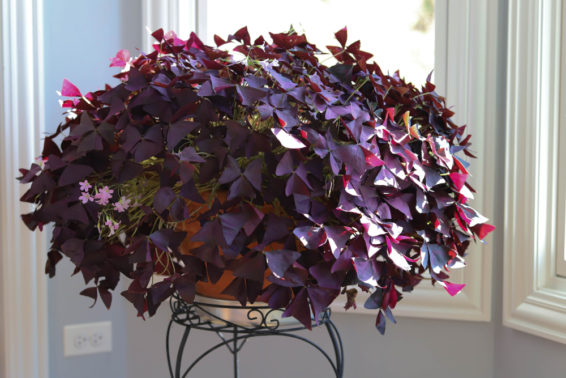
The False Shamrock or Purple Shamrock is a delicate looking houseplant with clover-shaped leaves and star-shaped pink and white blooms. Oxalis regnellii is an edible perennial plant species belonging to the Oxalidaceae species. It is native to several countries in America and South Africa and it is grown as a houseplant.
Another jaw-dropping feature of this plant is the closing of its leaves and flowers and resembling tiny umbrellas. The pink and white flowers of this bulb-type plant look beautiful amidst those purple-hued leaves.
The plant care is not too fussy as well. It just needs bright and indirect light, and watering only the topsoil is dry. Don’t let children or pets ingest the leaves of this plant as they are toxic.
19. Palms
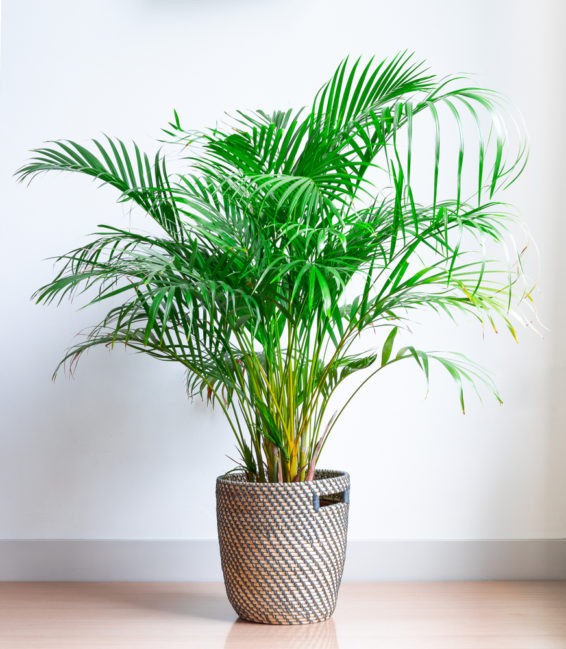
A ‘plant it and forget it’ variety, the Arecaceae or Palms are a botanical family consisting of perennial flowering plants. Their growth can be varied from climbers, shrubs, and even tree-like structure—all known as palms.
Consider getting small palm shrubs as houseplants as they are wonderful for beginners. Unless you overwater it, palms are generally indestructible, no matter how much neglect it has to tolerate.
This slow-growing species can be grown in any soil with good drainage and indirect sunlight for better growth. Water it only when the top 2 inches of the soil is dry and you will see it thrive.
20. Philippine Evergreen
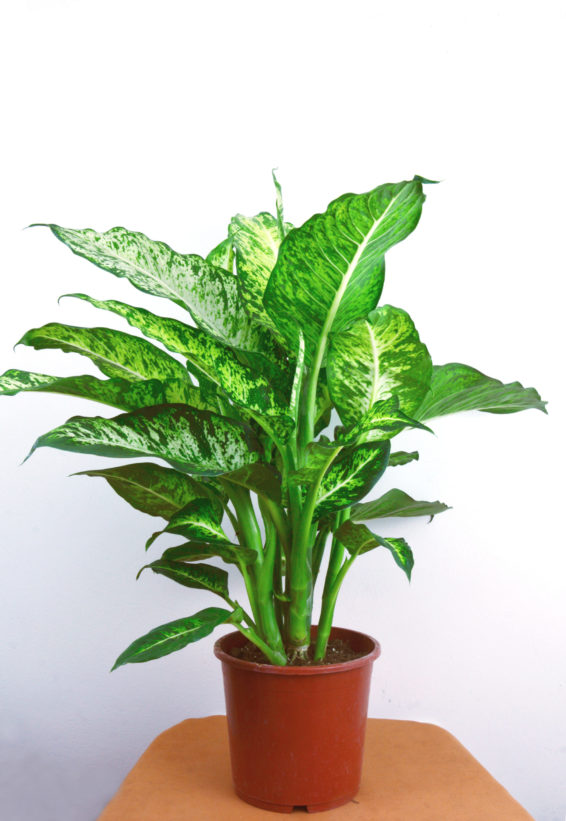
Aglaonema commutatum, commonly known as Chinese or Philippine evergreen, is one of the most adaptable and durable houseplants. It resembles dumb cane in the foliage part and it is one of the most sought after evergreens for beginners as it’s pretty low maintenance.
It is a slow-growing plant that can live for 10 or more years with proper care. The standout feature for this one would be those arching, lance-shape leaves which are variegated with strikes of silver and gray amidst the green shade.
Chinese evergreen needs low to medium light for survival. You can grow it separately or together with a large group of low-light plants. The soil should contain just enough moisture, so water the plant only when the topsoil is dry.
The juice of the leaves can be toxic for humans and pets and the major symptoms include skin rash and irritated mucus membranes.
21. Flamingo Flower
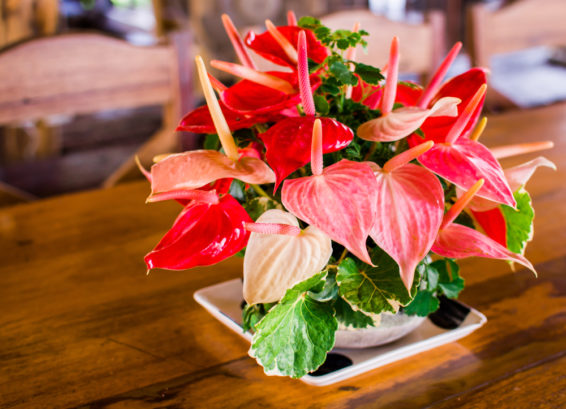
Anthurium or Flamingo Flower plant is well-known for those heart-shaped, deep red-colored flowers. They have dark green leaves with glossy foliage and those red flowers are sort of a protective spathe which acts as a barrier around the plant’s finger-like spadix. These waxy flowers can be great if you are using it as an ornamental plant.
Another unique thing about Anthurium houseplants is the peculiar roots that make an appearance above the soil—this is totally normal. These plants would improve the decor of your house as they provide vibrant red flowers all year round.
The plant care includes using coarse potting soil, positioning the plant on a sunny spot with indirect sunlight, and maintaining a humid environment. Water your anthuriums regularly but make sure that you don’t overwater. If you notice that the glossy effect of the leaves is gone, give it more moisture.
This plant won’t be a good choice if you have pets at home as they can cause calcium oxalate poisoning if ingested and damage the liver and kidney. Look out for this issue and you are good to go with the Flamingo flower!
22. English Ivy
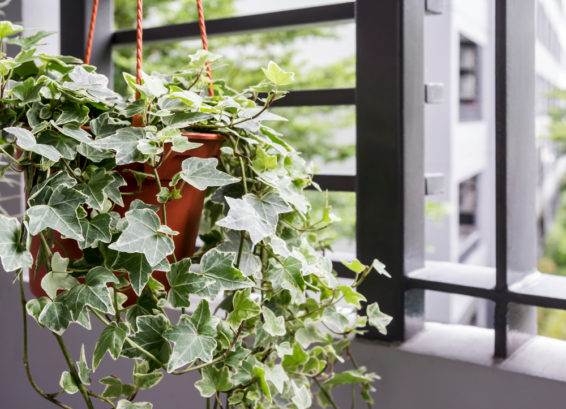
Hedera helix, commonly known as English Ivy or European Ivy, is a flowering plant native to western Asia and Europe. It has thick glossy leaves with white or yellow veins, forming nice foliage. It is an ornamental plant and you can let it grow on hanging baskets for a nice touch.
Taking care of an English Ivy is fairly easy. They need bright, indirect light and room temperatures to survive. Don’t water it unless the topsoil is dry by 2 inches and it would be happy. Use fertilizers once a month in spring and summer.
Regular check is necessary for this one and you must keep children and pets away from it. The hanging leaves look very attractive, but they are toxic! Also, it can gather a significant amount of dust and attract pests if you’re not careful.
23. Ponytail Palm Houseplant
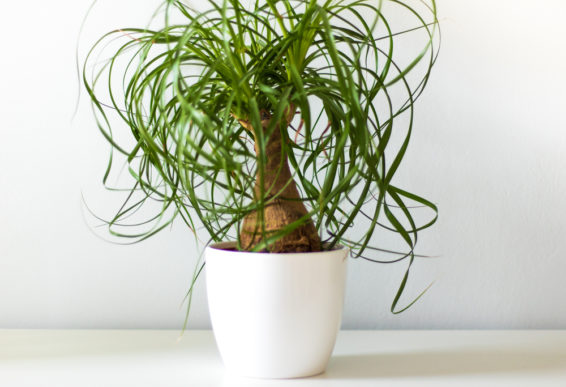
If you want to bring home a unique houseplant with an extra-unique trunk, go for Ponytail Palm. The Beaucarnea recurvata, also known as the elephant’s foot, belongs to the plant family of Asparagaceae and is native to parts of eastern Mexico. Though it has ‘palm’ in its name, it’s not closely related to a typical palm plant.
The long, hair-like leaves, bulbous water-storing trunks and the basic appearance of the plant is appealing. The waxy leaves can grow up to 3 feet tall and they generally cascade from the top—this is my favorite part about this succulent.
If you are a beginner, you might forget watering often but the bulbous trunk has got your back. Also, the soil should completely dry out before you water again. Bright, indirect sunlight is the best for this plant. It is sensitive to over-fertilization, so fertilizing it once or twice a year would be just fine.
24. Philodendron
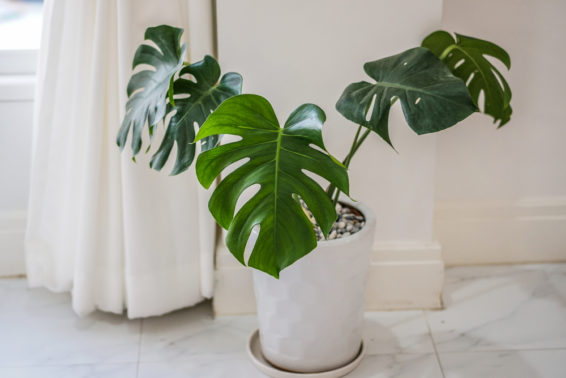
Philodendron hederaceum oxycardium or Philodendron, a major genus of the flowering family of Araceae. It is native to tropical America and has over 400 species. This durable plant along with its heart-shaped leaves is a favorite among everyone. This slender stem climber looks so sober and is the perfect green addition for your indoors.
The stem can grow up to 4 inches long and it is an adaptable plant. It is not much sensitive to change in the environment and it is a good choice for beginners. You can try growing small specimens in mixed baskets and dish gardens to group them with other similar plants.
Mimic the light provided by a tropical canopy to keep your plant happy—too much direct light can turn the leaves yellow. Philodendron needs evenly moist, organic soil to grow and stay healthy. When the leaves appear dry, you can spray water on them and your job is done.
25. Aloe Vera
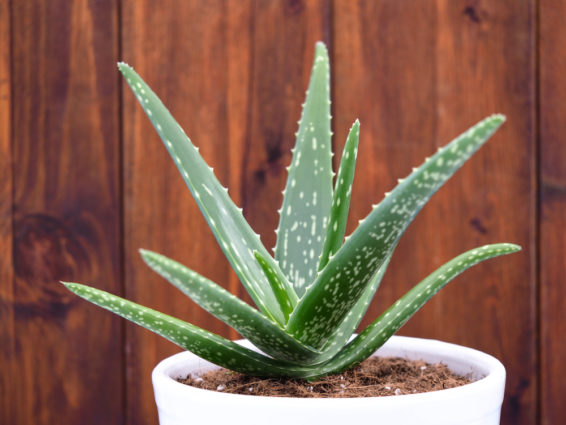
A wonderful choice for beginners, Aloe vera is one of those succulents that are satisfied with minimal care, and in return, have tons of benefits for us. This succulent species belong to the genus Aloe and is native to the Arabian peninsula. It is widely cultivated across the globe for medicinal and agricultural purposes.
With over 500 known species, Aloe can also be a good houseplant. Those elongated leaves that fan out from a center in a vase shape could bring in a distinct amount of greenery indoors. Aloe vera is a good choice for a sunny kitchen window and you can take out the aloe gel which is known for curing burns, skin rashes, acne and so much more.
It would need bright light to survive, and moderately dry soil. A window would be the best position for this one. Since it loves to grow in a hot and humid climate, water it only when the topsoil is dry.
26. Air Plant
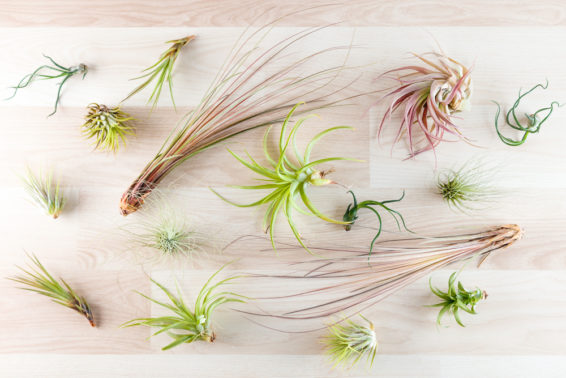
Tillandsia or Air plant is a genus of evergreen perennials belonging to the family Bromeliaceae. It is mainly native to the forests, mountains, and parts of deserts in Mexico, Argentina, and the United States.
It is one of the easiest plants to care for and according to some Italian studies, it can even purify the air. Air plants hold an astonishing array of colors and forms—the blooms will last from a few days to a few months. These plants rely on leaves and not roots to absorb water and air.
Tillandsia needs bright, indirect light, and room temperature to thrive. It doesn’t need any soil to grow—just soak the plant in water every1-2 weeks for about 10 minutes and let it dry naturally in a bright space. You can also mist the leaves with water once a week. The plant’s ability to grow without soil makes it a winner according to me!
27. Crown of Thorns
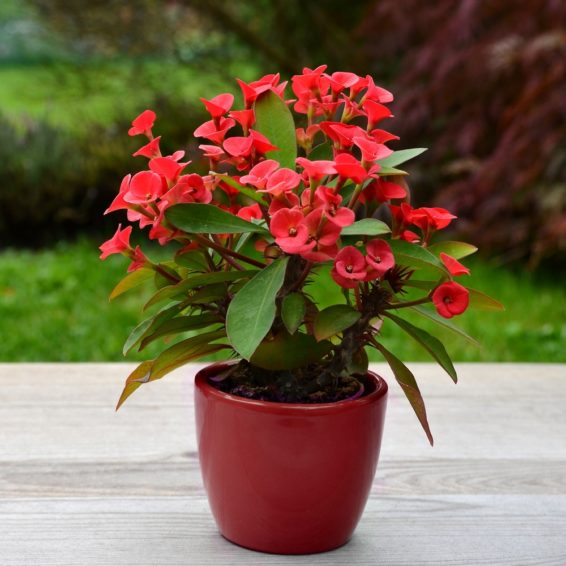
A plant that can produce prickers, Crown of thorns, or Euphorbia milii belongs to the spurge family of Euphorbiaceae and is native to Madagascar. It is also called Christ plant or Christ thorn and it is mainly an ornamental succulent—you can plant it near a wall to beautify it.
It is a sprawling evergreen succulent with red and pink vibrant blooms that stays all-year-round. Crown of thorns can survive without water for about a week or more and this is an amazing starter plant for beginners.
To keep it healthy, it needs sunlight for at least half a day and room temperature. It will also rot if you try to grow it in a lot of soil—the container it is planted in should only be a couple of inches larger than the root ball. Water it only when the topsoil is dry and your very own Christ thorn would be covered with attractive blooms throughout the year!
28. Fiddle-Leaf Fig
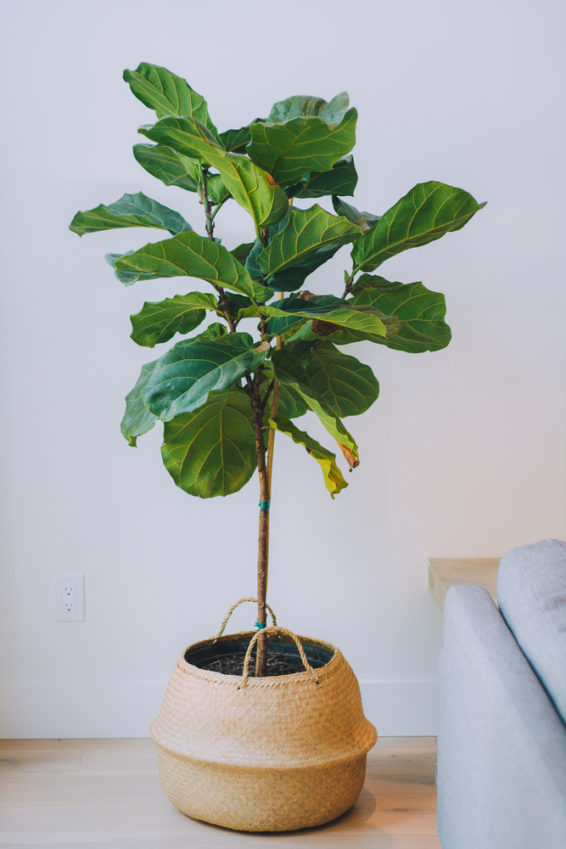
Ficus lyrata, also known as the fiddle-leaf fig, is a flowering plant belonging to the mulberry and fig family. Native to western Africa, in the lowland tropical rainforest, this piece of art can grow up to 50 m tall in its natural habitat (10 m indoors). It has been featured several times in interior design magazines—this one’s a beauty.
The violin-shaped leaves are big, waxy, and dark green and you will get that aesthetic vibe from them. Being a tropical species, it does prefer a hot, wet, and humid environment, but you can mimic this environment in your home.
Provide the fiddle-leaf fig with plenty of filtered, bright light and plenty of water (don’t overwater it though). It does require a little bit more attention than any average houseplant. So, if you are a beginner who has enough time on your hands, go for it!
29. Calathea
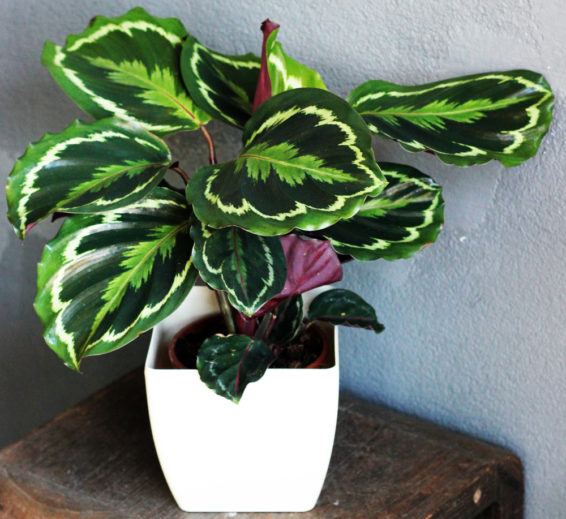
Calathea, a genus belonging to the Marantaceae family, is native to tropical Americas and there are several popular species in this genus. It is mainly used as an ornamental houseplant due to the variegated and shaded leaves.
Sometimes called prayer plant, its foliage can even outshine a bouquet of colorful flowers. You don’t need a botany degree to grow and care for one. They aren’t a fan of bright lights, so avoid placing them near windows.
Water your prayer plants every1-2 weeks and allow the soil to dry in between. They also thrive in humid conditions.
30. Schefflera
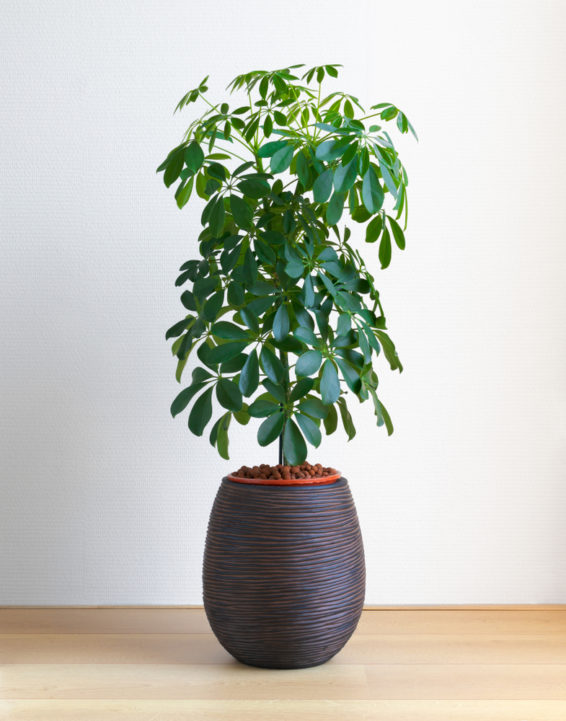
A genus of flowering plants in the Araliaceae family, Schefflera has about 900 species. It has shiny, oval green leaves that droop with grace, and together with the beautiful stalk, resembles an umbrella. Thus, it’s also known as the Umbrella Tree.
Schefflera acts as a natural air freshener and detoxifier, so be sure to get one for your house.
Caring for this one is relatively easy and can be a good choice for beginners. Being a tropical plant, it prefers a slightly warm environment and medium, indirect light. Schefflera is often killed by overwatering—hence, water it only when the soil pot dries out. Use fertilizers in spring and fall 1-2 times a week.
While handling this plant, wear gloves as the sap contains calcium oxalate crystals which can irritate the skin. Make sure your pets don’t ingest it either, as the plant is toxic.
31. Arrowhead Vine
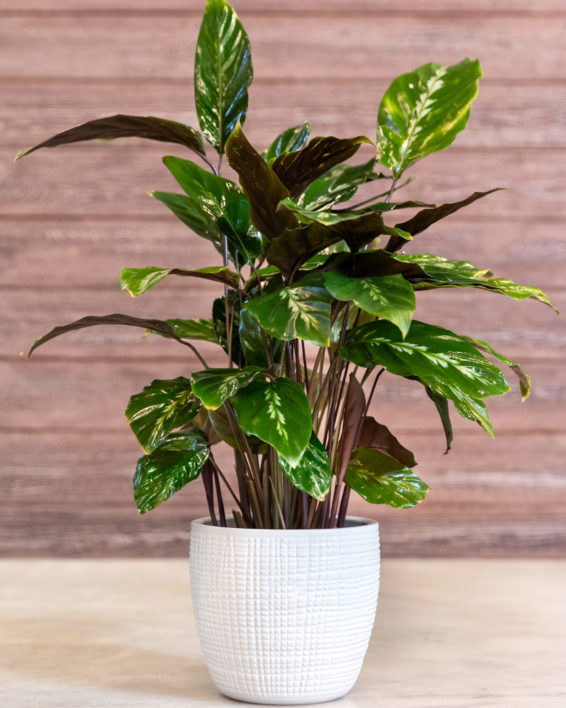
Syngonium podophyllum is a species of aroid and has common names like arrowhead plant, arrowhead philodendron, goosefoot, and African, and American evergreen plants. The names are interesting and so is the green foliage with white patterns in between.
To care for this highly appealing houseplant, you have to position it in a bright room, away from direct sun, and let the topsoil dry slightly before you water it. You can use an all-purpose potting mix for this one and it would be happy.
This plant must be kept away from pets as it is toxic—it must not be ingested. But overall, this is an amazing climbing plant and good for beginners as well!
We have reached the end of the list of some of the best houseplants for beginners—not only are they easy to care for but also look fabulous as well. Indoor plants bring so much beauty and greenery to your home and if you are trying to encourage your gardening skills, I don’t think there could be anything better than these low-maintenance houseplants. These plants are durable and most of them can withstand a decent amount of neglect. Choose your favorite and get to work right away!

